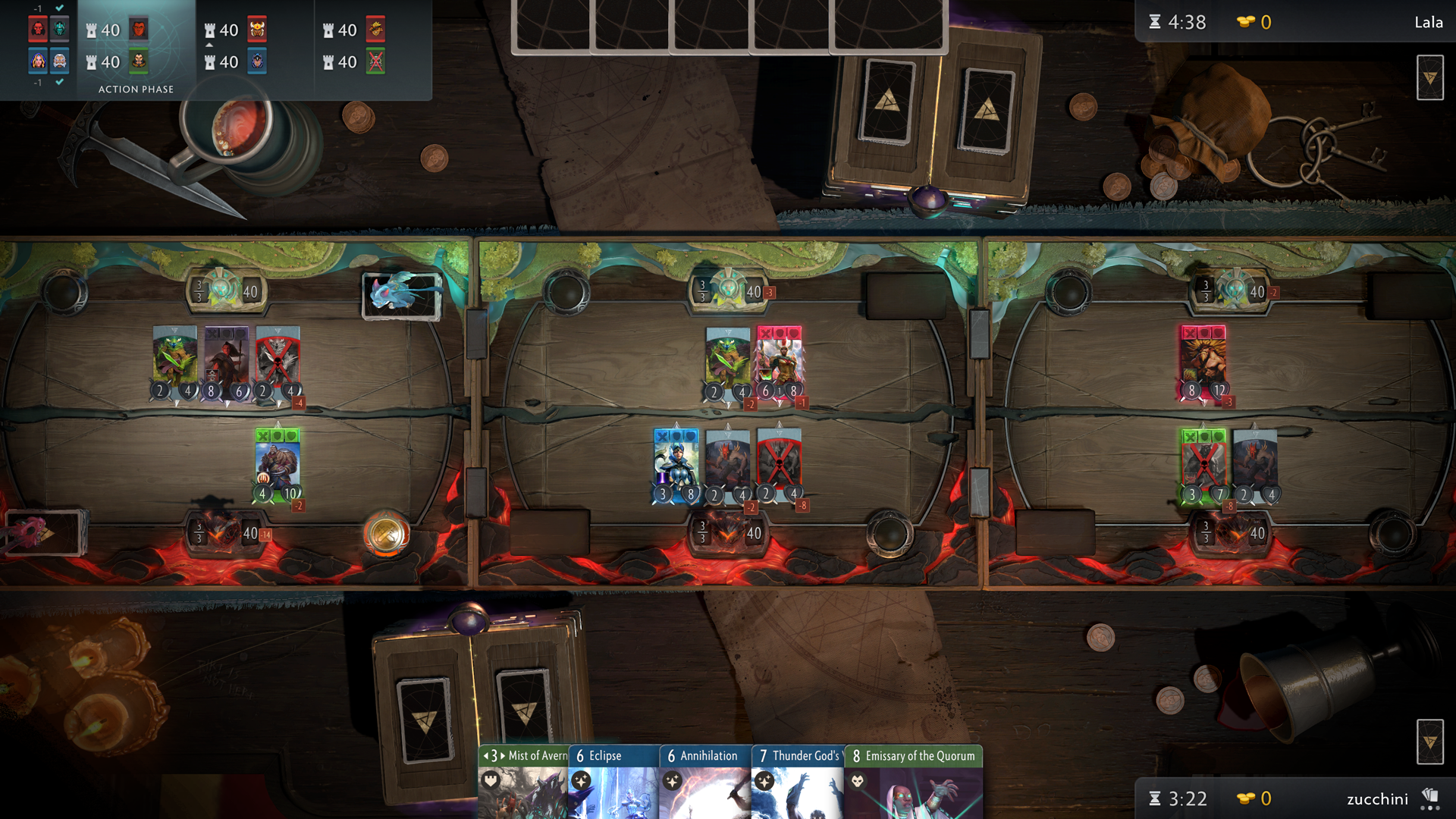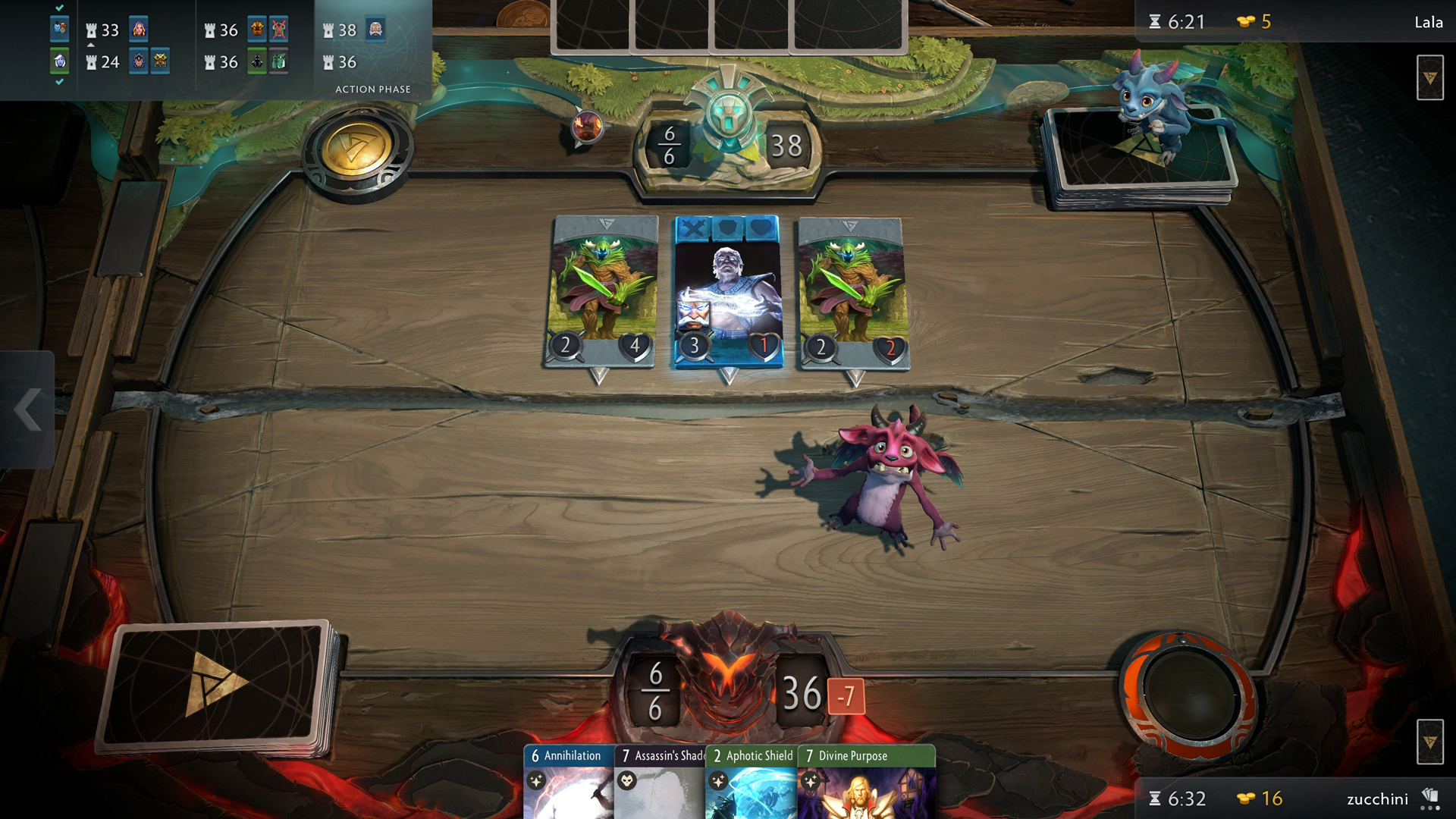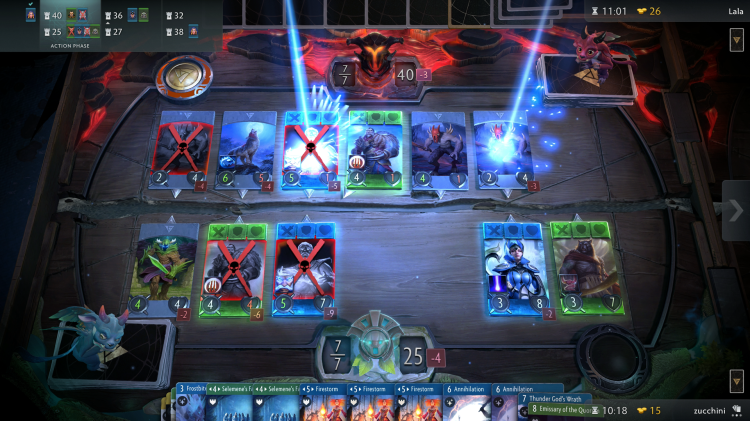I’m a big Hearthstone fan, and no other digital card game has competed against Blizzard’s market king for my affections. The Elder Scrolls: Legends? No thanks. Gwent? Get bent. But Artifact, Valve’s upcoming digital card game based on Dota 2, is interesting.
Artifact takes the collectible card game DNA established by Magic: The Gathering and forms it around MOBA traditions like lanes and shops. It has a lot going on. In terms of systems, Artifact makes Hearthstone look like a “my first card game” experience.
I tried to divulge everything I learned about Artifact during my recent visit at Valve. But I also want you to know that it’s fun. Yes, it’s deep and a little overwhelming, but Valve is smart to take a different approach — making a more complex game.

Above: You have three boards — or lanes — to mange.
Expand your mind
In my two demo games, I noticed some things that Artifact does better than Hearthstone. The first few turns are more interesting. You start with heroes and creeps already in play, so you’re making important decisions from the start. In Dota 2, heroes are the player characters, while creeps are the weaker, computer-controlled creatures. They have a similar power distribution in Artifiact, with heroes being much stronger but less plentiful than creeps. All of the heroes are based off characters from Dota 2.
June 5th: The AI Audit in NYC
Join us next week in NYC to engage with top executive leaders, delving into strategies for auditing AI models to ensure fairness, optimal performance, and ethical compliance across diverse organizations. Secure your attendance for this exclusive invite-only event.
You also have three game boards to worry about. Each one is a battle against your opponent to destroy their tower while defending your own. This is another idea taken from MOBAs, where destroying enemy towers is a big key to success. In Artifact, destroying two of your enemy’s three towers nets you a victory. So you have this element of strategy that goes beyond hoping for lucky card draws. Which lanes do you want to focus on? Is it worth conceding one board so you can focus on another?
Even if one tower falls, you can’t just abandon that board. A destroyed tower turns into an ancient, which has 80 health instead of the tower’s 40. Killing a single ancient wins the match. So you can concede a lane to your opponent, but you can’t leave it so defenseless that the opponent can kill your ancient.
Even outside of having three boards, Artifact has a lot of differences compared to Hearthstone. It has no limit to the amount of cards you can have in your hand (sorry, mill fans) or in your deck. It doesn’t even limit the amount of maximum mana or the number of minions you can have on the board.

Above: A hero card.
You go, I go, you go, I go …
Turns themselves are different than how they work in Hearthstone. You don’t just use as many cards as you want and then pass the baton to your opponent. Each turn, you can either play a card or pass. If you play a card, your opponent has a chance to play. Minions only attack once both players have passed their turn without playing anything. This means that each play has the chance to be countered, and it also limits how much a player can do without giving their opponent a chance to retaliate.
The differences between Artifact and Hearthstone keep piling on. Sure, Artifact also has spells, but it also has cards that impact boards with ongoing effects. These could give your characters an attack boost each round, or they could let you deal 4 damage to a targeted enemy each round.
Artifact doesn’t have classes like Hearthstone. Like Magic: The Gathering, heroes belong to one of four colors: blue, red, black, or green. Spells also belong to one of these colors, and you can’t use a spell of a certain color unless you have a corresponding hero on that board. So if you want to cast a blue spell, you need to have a blue hero on that lane. It adds another element of strategy when deciding where to place your heroes.
While Hearthstone’s decks can only contain neutral cards or ones from a single class, you can mix and match Artifact’s colors any way you want (again, like Magic). You can have an all blue deck, or even one with all four colors (probably not a great idea, but you can do it).
I played with a blue/green and red/black decks. Each felt distinct, with the blue/green one focusing on spells and buffs while the red/black deck specialized in strong heroes.
Deckbuilding is also different. Hearthstone has you making a deck of 30 cards. Artifact is more open, but it does have guidelines. You have to have at least 40 cards, but then you can have as many more than that as you want. But you can only have 5 hero cards, so your other cards will be spells, shop cards, and other non-hero ones.
The shop cards themselves are another distinct element for Artifact carried over from MOBA traditions. Killing enemies gives you gold. After a round, you can spend gold to buy cards from the shop. These are things like armor and weapons for heroes that will increase their health and attack power. Cards you buy with gold don’t cost any mana to use, unlike normal spells.
I didn’t get to see deck-building first hand, so I’m not exactly sure how it all works. But players will have a lot of freedom when making their decks.

Above: Aren’t those imps cute?
Is more complex better?
It’s impossible for me to grasp all of Artifact’s intricacies after a couple of games. But giving players three boards to worry about makes it a compelling experience. It forces you to think bigger with strategies, while also making it less likely for a single card to swing an entire game. Compared to Hearthstone, Artifact could end up being a game that rewards player skill over random effects.
Now, being more complicated doesn’t make Artifact better than Hearthstone. Part of Blizzard’s card game’s charm comes from its relative simplicity. Artifact may not be as accessible to as wide an audience. But the depth makes it stand out, which is the most important thing Valve can do to help Artifact have a chance of becoming the new digital card game king.


